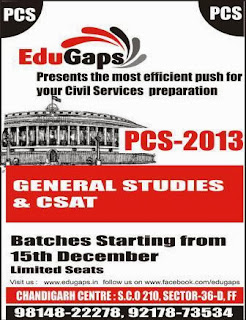1. VACANCIES :-
No Name of Post No. of Posts
1 Punjab Civil Service
(Executive Branch) 23
2 Deputy Superintendent of
Police 10
3 Deputy Superintendent of
Jails (Grade-II)/ District Probation Officer (Jails) 16*
4 Excise & Taxation
Officer 52
5 Tehsildar 06
6 Block Development &
Panchayat Officer 11
7 Labour & Conciliation
Officer 02
Note : 1* The vacancies of
Deputy Superintendent of Jails (Grade-II)/ District Probation Officer (Jails) are provisionally
incorporated in accordance with letter No. 1/236/2011-1J/ 131652/1 of Department of Home Affairs,
Govt. of Punjab and is subject to the final approval of the Govt.
Note: 2** The number of posts
may be increased or decreased by the Govt. at any time before the selection process is completed
without giving any prior notice to the candidates.
(i) The candidate should
possess a Bachelor's degree in any discipline from a recognised university or
institution. Provided that the candidate may be permitted to take Preliminary Competitive
Examination while studying for his degree. However, the candidate shall be
required to produce proof of passing the degree course for being eligible to take the
Main Competitive Examination during that year.
(ii) The Candidates must have
passed Punjabi of matric or its equivalent standard as on the last date of receipt of
Online application Form i.e. 30th December, 2013







